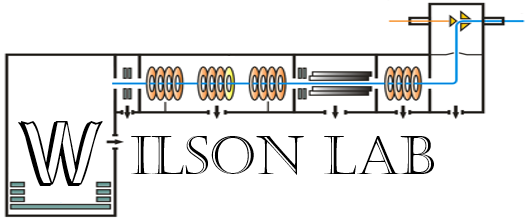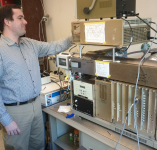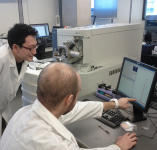
The Center for Research in Mass Spectrometry (CRMS) is an internationally-recognized ORU focusing on mass spectrometry and related research. CRMS embodies a long-standing area of strength in FSc, with world-class contributions to research areas ranging from gas-phase ion chemistry to clinical proteomics. CRMS continues to provide research leadership, a focus for research intensification and a platform for advancement and outreach to the Faculty of Science at York Univeristy. Currently there are 4 major core research areas: Proteomics, Protein Dynamics, Imaging and Fundamental/Instrument Development.
Proteomics
Funded By: National Science Engineering Research Council (NSERC) Discovery and IRC, ISTP Canada, Canadian Institute for Health Research (CIHR), Canadian Cancer Society Research Institute (CCSRI), Canadian Foundation for Innovation (CFI), Ontario Innovation Trust (OIT), Ontario Research and Development Challenge Fund (ORDCF), Genome Canada, National Research Council (NRC), Ontario Cancer Biomarker Network (OCBN), AB Sciex, and Sanofi Pasteur industrial partners among many other agencies.
Research: The focus of the proteomics section of the CRMS is the development and application of new tools for the identification and quantification of ensemble of proteins. Projects include shotgun organellar proteomics of Tetrahymena thermophila and the investigation of myogenesis-related proteins and their posttranslational modifications. Another important aspect of our research is the discovery of cancer biomarkers, as well as their identification, verification, and quantification in endometrial, brain, head-and-neck, ovarian, and kidney cancer. Current and former collaborators include Drs. Dasantila Golemi-Kotra, Ronald E. Pearlman and John C. McDermott (York University); Ranju Ralhan, Terence J. Colgan, Christina M. MacMillan, Ian J. Witterick, and Iona Leong (Mount Sinai Hospital); Alexander D. Romaschin and George M. Yousef (St. Michael’s Hospital); Abhijit Guha and Gelareh Zadeh (Hospital for Sick Children and Toronto Western Hospital); and Kenneth R. Evans and Terrence Sills (Ontario Cancer Biomarker Network).
The facility has a suite of mass spectrometric instruments and new instruments are periodically acquired to ensure that the facility remains state-of-the-art. The combination of instruments and expertise that the facility can access permits us to undertake research projects that require a great deal of analytical flexibility and expertise.
Protein Dynamics
Funded By: NSERC Discovery, NSERC CRD, CFI, Ontario MRI, Alzheimer's Society of Canada
Research: Understanding the Role of Structural 'Disorder' in Protein Function and Pathogenenic Misfolding. The tools of structural biology (X-ray crystallography and Nuclear Magnetic Resonance) have provided us with beautiful, high resolution snapshots of protein structure. However, if proteins were truly as static as they appear in those images, most would be completely non-functional. Motion is a crucial component of how proteins carry out their biological roles and also to how they adopt pathogenic structures in diseases like Alzheimer's and Parkinson's. Research in the Wilson Group centers on the development of new mass spectrometry-based tools to precisely measure the motions that proteins *must* undergo as they catalyze reactions, interact with their binding partners, become modified or undergo structural changes that are linked to disease. Our work is equal parts methods development, where we introduce new mass-spectrometry coupled microfluidic devices to support our work and biochemical, where we acquire new insights into dynamics and protein function. Our major contributions so far have included a new 'epicatalytic' model for the manner in which enzyme motions underlie catalysis (Angewandte Chemie Int. Ed., 51(38), 9666-9669), a new way of identifying allosteric 'hotspots' on enzymes (Lab Chip, DOI: 10.1039/C3LC00007A ) and a microfluidic chip for 'time-resolved' protein dynamics measurements (Anal. Chem., 84(8), 3771-3779).
Imaging
Funded By: NSERC Discovery, NSERC Engage, NSERC CREATE
Research: Imaging mass spectrometry adds a spatial dimension to mass spectrometric analyses, combining information about analyte localization with the exceptionally detailed chemical characterizations that only mass spectrometry can provide. With this approach, tissue samples (including biopsies), fingerprints and even whole organisms can be probed for chemical composition with a spatial resolution in the low micron range. Imaging mass spectrometry is a core priority for CRMS and our Associate Director Dr. Ifa has brought a new imaging technology to the faculty in the form of Desorption ElectroSpray Ionization (DESI). He has already initiated collaborative projects with numerous faculty members both within and outside of CRMS. Mass spectrometry imaging (MSI) refers to procedures in which both chemical information and spatial information are acquired for later processing and visualization as chemical images. The experiment can be used to record 2D or 3D images. MSI has emerged as a promising technique in many areas, including the biomedical sciences, material sciences and forensics, owing to its high chemical specificity and relative ease of application.
Fundamendal/Instrument Development
Funded By: NSERC Discovery, NSERC CREATE
Research: Mass Spectrometry has rapidly matured as an analytical technique over the last two decades. One of the features of this maturation has been a transfer of instrument-development research from academia to industry, and a concomitant explosion of industrial players in the mass spectrometry business. There are presently more than 10 major vendors of MS instrumentation including science instrument giants Agilent, Thermo/Finnigan, Shimadzu, Waters and ABSciex among others, resulting in intensified competition and shortened product upgrade cycles. Academic research has shifted in focus toward applications, closely linked with industrial partners who are eager to showcase the scientific advances that their new technologies facilitate. As a unit with internationally-recognized strengths in both applications and instrument development, CRMS generates highly-impactful research in this new and fast-evolving environment. CRMS' increased focus on bioanalytical applications coincides with a fundamental shift in the pharmaceuticals industry towards protein-based drugs, a change for which bioanalytical mass spectrometry will provide the analytical foundation.
Visit the CRMS website for more information: http://mass-spectrometry.ca/


